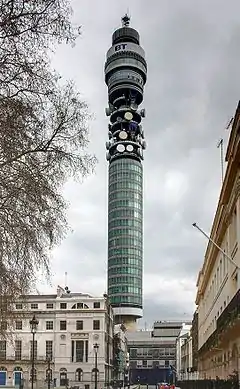Eric Bedford (architect)
Eric Bedford, CVO, CBE (8 November 1909 – 28 July 2001) was a twentieth century British architect whose most famous work is London's BT Tower. In 1961, construction began on what was then known as The Post Office Tower, with Bedford as Chief Architect and G R Yeats, senior architect in charge. Completed in 1961, with a height of 177 metres (581 ft), it became London's tallest building.
Eric Bedford, CVO, CBE | |
|---|---|
 Lector si monumentum requiris circumspice | |
| Born | 8 November 1909 Halifax, West Yorkshire, England |
| Died | 28 July 2001 (aged 91) |
| Nationality | United Kingdom |
| Alma mater | Thornton Grammar School |
| Occupation | Architect |
| Buildings | BT Tower |
Born in Yorkshire, and trained as an architect in the Midlands, Bedford joined the Ministry of Public Building and Works in 1936. In 1951, he was appointed the Ministry's youngest ever Chief Architect. Shortly after, Bedford had an important role in the design of the Coronation of Queen Elizabeth II, for which he was subsequently made a Commander of the Royal Victorian Order.
Bedford retired in 1970 and lived abroad for some years before dying in 2001. As the architect responsible for one of London's most iconic buildings, Bedford achieved surprisingly little recognition in his lifetime, or afterwards, his obituary in The New York Times describing him as; "the British government's anonymous chief architect, whose works were visible to millions but whose name was scarcely known".[1]
Life
Bedford was born on 29 August 1909 near Halifax in Yorkshire.[2] He was educated at Thornton Grammar School and then undertook an architectural apprenticeship in Leicester.[3] In 1934 he won a RIBA medal for his design for a railway terminal.[4] Two years later, he joined the Ministry of Public Building and Works and, after the Second World War, was appointed its youngest ever Chief Architect.[4] At the Coronation of Queen Elizabeth II, Bedford had responsibility for significant elements of the overall design, including the Coronation Arches.[3]
Given its importance to government communications, the BT Tower was designed to withstand nuclear attack, and in 1971 it was relatively undamaged by an bomb placed in the tower's revolving restaurant by the Angry Brigade.[5][6] Bedford's comment was recorded as; "I made it to last, bombers or not".[7] In addition to the tower, Bedford oversaw or undertook a number of other important governmental commissions; both within the UK, including the departmental buildings on Marsham Street, Westminster and offices for MPs within the Palace of Westminster;[3] and overseas including embassy buildings in Warsaw, Washington, D.C. and Jakarta.[3]
After retiring to France to be near his daughter,[8] he returned to England following the death of his wife in 1977. He lived for many years in the village of Hanley Swan near Malvern, Worcestershire. Bedford died in a nursing home in Worcester in 2001.[9]
Works
- Administrative offices of the Embassy of the United Kingdom, Washington, D.C., 1960s[10]
- Marsham Street, government offices, 1963-71.[8] Pevsner considers Bedford's work at Marsham Street "ruthlessly logical"[11] but a "spectacular failure, the very image of faceless bureaucracy." [12]
- St James's Park footbridge 1956-7[9] The, slightly back-handed, compliment in Pevsner is, "quite handsome, and good to look out from" but the authors consider the Victorian cast iron suspension bridge it replaced "a great loss."[13]
- Embassy of the United Kingdom, Jakarta, 1962.[8] The embassy was subject to anti-British demonstrations throughout its existence and the site was vacated in 2015.[14]
- British High Commission, Ottawa, 1964.[3]
- BT Tower, 1961-5.[15] Pevsner describes it as "a notable 1960s landmark."[16]
- Office accommodation, Star Chamber Court, Palace of Westminster. Pevsner's single comment is "ugly." [17]
Notes
- "Eric Bedford, Who Changed London's Skyline, Dies at 91". The New York Times. 13 August 2001.
- "Eric Bedford; Architect - latimes". Articles.latimes.com. 21 December 2001. Retrieved 22 January 2017.
- 12:00AM BST 08 Aug 2001 (8 August 2001). "Eric Bedford". Telegraph. Retrieved 22 January 2017.
- "Eric Bedford". The Independent. Retrieved 22 January 2017.
- Bright, Martin (2 February 2002). "Look back in anger". The Guardian. ISSN 0261-3077. Retrieved 21 April 2016.
- "Bangor Daily News – Google News Archive Search". news.google.com. Retrieved 21 April 2016.
- Aslet 2005, p. 126.
- "Eric Bedford".
- "Eric Bedford". 14 August 2001.
- "Eric Bedford, Who Changed London's Skyline, Dies at 91". The New York Times. 13 August 2001.
- Bradley & Pevsner 2003, p. 86.
- Bradley & Pevsner 2003, p. 705.
- Bradley & Pevsner 2003, p. 654.
- Post, The Jakarta. "UK opens new bigger, better embassy in Jakarta".
- Historic England. "BT COMMUNICATION TOWER (1350342)". National Heritage List for England. Retrieved 22 January 2017.
- Cherry & Pevsner 2002, p. 262.
- Bradley & Pevsner 2003, p. 218.
Sources
- Aslet, Clive (2005). Landmarks of Britain. London: Hodder & Stoughton. ISBN 978-0-340-73510-7.
editions:O60YB-B7LYMC.
- Bradley, Simon; Pevsner, Nikolaus (2003). London 6: Westminster. The Buildings of England. Yale University Press. ISBN 0 300 09595 3.
- Cherry, Bridget; Pevsner, Nikolaus (2002). London 4: North. The Buildings of England. Yale University Press. ISBN 0 300 09653 4.